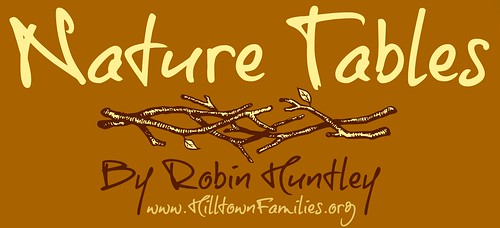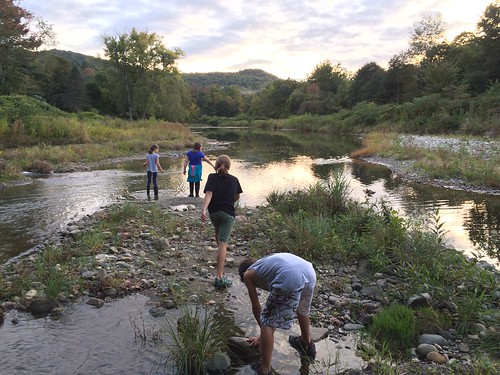Nature Table for October
Stories in the Landscape

Every month, Hilltown Families features a new nature table whose contents inspire learning along a common theme easily spotted in our surroundings that month. A tradition carried out by teachers, environmental educators, and nature-curious families, nature tables bring a little bit of the outdoors inside for inspection, dissection, identification, creative play, art projects, and lots of other educational activities. The idea behind a nature table is to help open up children’s eyes to the unique attributes of each season, and to help them learn how to see these things in nature for themselves. A nature table can include a variety of items, and is often accompanied by a set of books and/or field guides so that children can take part in further learning at their own will.
It is during the turning of seasons that our own affect on the local landscape becomes most apparent. While the life that surrounds us makes its colorful and dramatic shift from summer to autumn, the portions of our landscape that to which phenology does not apply become all the more apparent. Our houses, our roads, our street signs, our stop lights – all of these things remain relatively unchanged as the seasons go by, refusing to yield to the gentlest forces of nature. Because our awareness of our surroundings involves the consideration of both natural and man-made elements, we become all the more aware of seasonal changes when they are contrasted with the lack of change elsewhere.
Recently, we’ve celebrated the end of river wading season and have spent some time exploring the shallow current of the river. Amidst discoveries of crayfish, caddis flies, and volcanic rock are discoveries of things that, unlike small creatures and stones, did not end up their on their own. In sloshing our way downstream to conduct this year’s Rapid Biotic Assessment, we found everything from bits of pottery to an oil filter, reminding us every few steps of the role that our own lives play in the life of all rivers.
Discoveries of bits of recognizable everyday items prompted many questions about how those things could have ended up where we found them, despite their obvious origin. Our discussion of the treasures we found managed to skirt the truth, and none of us could quite stomach the idea that the dishes, the terracotta pots, the wire, the plastic shopping bag, the cardboard cup, and yes, especially the oil filter were in the river as a result of human carelessness. To give the community upstream credit, we told lots of stories about the storm-swollen beast that our river became during Hurricane Irene a few years ago, one-upping each other with stories about barely-believable floating debris. Entire fields of pumpkins! Bales of hay 12 feet up in trees! A house!

Our trash-to-treasures human-created nature collection has dried itself and sits guiltily in our classroom science museum, reminding us about the role of the impact each of us has upon our surroundings and the amount of control (big or small) we have over whether we’ll continue to be able to find such treasures. Our collection this month includes:
- bits of pottery
- pieces of terracotta
- rusty oil filter
- clam shells
- metal spoon
- glass
- fishing lure
- fence wire
Some books we’ll use as resources for thinking about our impact on nature include:
- A River Ran Wild: An Environmental History by Lynne Cherry
- Rachel: The Story of Rachel Carson by Amy Ehrlich
- Common Ground: The Water, Earth, and Air We Share by Molly Bang
- Nobody Particuar: One Woman’s Fight to Save the Bays by Molly Bang (teen)
Robin Morgan Huntley, Community-Based Education Correspondent
 A native to Maine, Robin joined Hilltown Families in early 2011. She is a graduate of Antioch University with a masters in education. Her interests within the field of education include policy and all types of nontraditional education. For her undergraduate project at Hampshire College, Robin researched the importance of connecting public schools with their surrounding communities, especially in rural areas. Robin lives and teaches 5th grade in the Hilltowns of Western MA and and serves on the Mary Lyon Foundation Board of Directors.
A native to Maine, Robin joined Hilltown Families in early 2011. She is a graduate of Antioch University with a masters in education. Her interests within the field of education include policy and all types of nontraditional education. For her undergraduate project at Hampshire College, Robin researched the importance of connecting public schools with their surrounding communities, especially in rural areas. Robin lives and teaches 5th grade in the Hilltowns of Western MA and and serves on the Mary Lyon Foundation Board of Directors.
 Hilltown Families
Hilltown Families 




























